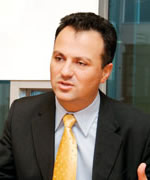Bonds to the rescue
Where can local authorities find financing if European structural funds prove to be a dead-end? Municipal bonds are coming into their own as the best alternative to free money, finds Corina Mica
 Following a wave of decentralisation by central Government, local authorities are now in total control of funding many of their own projects.
Following a wave of decentralisation by central Government, local authorities are now in total control of funding many of their own projects.
Therefore these institutions are looking for different types of financing and will be competing against each other for the largest grants from EU structural funds and the best terms from private investors.
One strong tried and tested formula is for local authorities to issue municipal bonds: these are debts that the municipalities put up for sale to allow a quick and fast cash-flow to fund its own projects.
An advantage is that inhabitants or companies from the local area can buy into the bond: therefore, ideally, it could keep the benefits of being a borrower and lender in the same region.
The security for the payback of the bond is also backed up by the fact that the local authority will always receive a steady stream of cash from its own constituents' tax revenues.
But municipal bonds have not taken off at the same rate as other eastern European countries that Romania is often measured against.
High inflation, local authority leaders still driven by an old mentality, volatile interest rates and a fear of big debt have marred the start of this financial alternative.
For local authorities, large amounts of cash from Europe, in the guise of structural funds, are also far more attractive – because they do not have to pay any money back.
Romania’s municipal credit market started only six years ago, with the seaside city of Mangalia taking the plunge in unknown waters, issuing municipal bonds valued at around 400,000 Euro to finance a sports hall and rehabilitating the pedestrian access to seaside cliffs.
“This was a real success,” Aida Gomeaja, director in the tax department of Mangalia City Hall tells The Diplomat. “The bonds were sold very quickly and we completed our investment projects. We also involved the city’s inhabitants in a debate to convince them that this is the best way to get the money we needed.”
But who was buying the bonds?
“The percentage of locals was low compared to institutional investors, like companies or even Financial Investment Companies (SIFs),” adds Gomeaja.
Over six years, about 42 local municipalities have received the approval from the National Securities Commission (CNVM) to issue and trade bonds, but there are no exact figures available as to the total value of this market.
Some estimates rise to the height of one billion RON, which would put it at about 300 million Euro used so far, excluding Bucharest, which last year issued a Eurobond worth 500 million Euro.
| Municipal bonds issued in Romania so far are estimated at around 800 million Euro |
How did it all begin?
Municipalities in Romania started financing themselves through issuing bonds one hundred years ago.
“The bond issue of Craiova, through which water infrastructure was financed in the city, is famous,” says Marius Bostan, senior partner with financial advisers VMB Partners. “The same thing happened in Bucharest. This is an old instrument, which was used before, but at the same time, forgotten.”
Back in 2001, Romania had an immature capital market and an economy still struggling with high inflation. Banks did not manage to win public trust and there were high and volatile interest rates. Together this lead to an unstable borrowing environment.
|
Then the law of public finance passed in 1998, which laid the ground for the reappearance of municipal bonds in Romania.
But this law states that a local authority can only borrow, yearly, up to 30 per cent of its annual budget – this is its local public debt.
“It took municipalities two years to get a grip and be able to develop a sound strategy in this field,” says Bostan.
But there is still hesitation to see bonds as a viable financing source.
“Until 2003 nothing that big happened on this market,” adds Laurentiu Ciocirlan, director for debt and equity origination at Raiffeisen Capital & Investment. “And then people at a city level were not yet used to the idea that they can actually borrow money. There is still reluctance in several cities and counties in Romania, but at the same time there are cities that are run by people that come from the private sector, and this is seen. Such an administration is more inclined to approaching the issue [of bonds].”
|
Local administrations' lack of experience and sophistication regarding the administration of local public debt has also contributed to this reluctance, argues Cosmin Anghel, associate with law firm Badea, Clifford Chance.
“Also the existence of the possibility to directly borrow money, guaranteed by the state, has acted as a brake on the development of this market in Romania,” he says.
Another reason for the lack of enthusiasm for bonds has been that local authorities were not completely in charge of their own financing decisions until last year.
“This has kept local municipalities dependent on the central administration regarding financial decisions and strategy-making,” adds Anghel.
| Decentralisation of local administration is likely to see an increase in the appetite for municipal bonds |
|
Daniel Ivascanu, senior associate with Tuca Zbarcea & Asociatii, feels the delay in development compared to countries such as Poland, Hungary and the Czech Republic, was mainly caused by it not being a high-priority policy issue in the 1990s, with the best regulations not in place.
“In the absence of an adequate legal framework, there was a risk of excessive borrowing that could eventually lead to a major economic crisis which has already happened in other countries,” Ivascanu adds.
Until Romania could establish a stable macroeconomic environment, the development of a municipal credit market could not be assured.
Meanwhile, Marius Danila, executive director of the Group Management and Capital Markets Direction at Banca Comerciala Romania, blames the poor development of the local capital market for the delay.
|
Now local authorities need to work like a business in order to attract the best terms for financing. This means the authorities need to change their financial structures so their administration can absorb the funds available or come up with strategies to attract finance.
Antoaneta Curteanu, vice president of UniCredit Romania, responsible for the Corporate Division, says the development of the municipal bond market requires legal reform and institutional capacity building for local public authorities to use such instruments.
She also argues that there needs to be better accounting and financial information of local public authorities.
“For the reasons above and due to the fact that some county and city councils were more conservative accepting ‘modern financing instruments’, municipal bond issues appeared so late, but have increased to a significant level only from 2005 on,” says Curteanu.
More and more cities are now looking at bonds, argues Narcisa Muraru, executive director of the Romanian Municipalities Association (AMR).
“When municipal bonds were first issued, there was a fear present that, if not enough research is made, one can go wrong,” says Muraru. “At first there was distrust, but enthusiasm shown at the same time. Later on, those in charge realised it was worth it.”
Betting on debt |
|
Municipal bonds will be the next wave in terms of attracting money, argue finance experts, now that Romania is on a steady macroeconomic footing.
But local authorities are not that upbeat about the prospects. The Diplomat talks to regions with a history of issuing bonds. “We believe bonds should better Aida Gomeaja, director in the tax department of the Mangalia City Hall: “Mangalia was the first city in Romania to issue municipal bonds back in 2001, valued at ten billion ROL (around 400,000 Euro), and this was a real success. “Municipal bonds' development will not be extraordinary.” Emilian Sala, head of the economic department at Oradea City Hall: “Bonds will not be that profitable, as long as we can attract financing from other sources.” Valer Marginean, spokesman of the Arad City Hall: “The municipality of Arad issued its first and so far its last municipal bonds in 2003, valued at 65 billion ROL (1.9 million Euro). 20 billion of that was used to build a road connection between a passage and a road bridge, while the rest was used to modernise the road network. In the end it was a successful operation. The road connection is now in fact some sort of a ring road for the city, but that will be 'swallowed', once we complete the proposed ring road to take the heavy traffic from Deva to Timisoara out of the city limits. |
Starting to function
Now the bond market seems to be perking up.
“Compared with similar markets in central and eastern Europe, the growth in the municipal bonds in the past year has been relatively strong and there is every reason to believe that it will continue in the future,” says Edgar Jakab, attorney-at-law with Noerr Stiefenhofer Lutz. “The growing acceptance of the concept of municipal bonds and the sufficient familiarity of the local authorities with the role and function of the capital market will serve as a valuable alternative to the current financing options that are available for the local municipalities’ funding crises.
Mangalia was first, followed by the mountain resort of Predeal, and then 40 other local municipalities or county councils picked up the idea and started using the capital market as an instrument.
Despite all the difficulties, the listing of municipal bonds finally started in 2001 and ever since, the National Securities Commission has approved 42 public selling offers for municipal bonds.
Bucharest's City Hall issued its first international bond issue in 2005, planned at 500 million Euro, but this was in the end oversubscribed and reached 800 million Euro.
“The interest of foreign investors was very high, and the issue proved to be a success,” says Cristina Parvulescu, executive director of the Department for External Credits Management at the Bucharest City Hall.
The City could have attracted a lot more cash too – but the Ministry of Public Finance only authorised a 500 million Euro issue.
Moreover, adds Parvulescu, Bucharest’s Eurobond in 2005 was, at the time, eastern Europe’s biggest bond issue with the smallest interest (4.125 per cent)
Despite the interest from foreign investors in bonds, especially the Bucharest Eurobond, Anghel of Badea Clifford Chance says the local market is quite underdeveloped and not that liquid.
Where to go from here?
Now, as a member of the EU, Romania will benefit from structural funds amounting to about two billion Euro per year for the first three years of membership.
Although EU funds will contribute to the development of sectors such as infrastructure, IT, education, health, environment, rural areas and small enterprise, there is a growing need for financing which greatly surpasses the value of these structural and cohesion funds – a gap which municipal bonds could fulfil, especially in the capital.
“As Romania acceded to EU, it is possible that most of the local public authorities should access the structural funds and, in order to have sufficient funds as their own contribution to borrow money on financial markets by issuing and selling of municipal bonds or contracting loans from commercial banks or other financial institutions,” says Cristian Vlaicu, associate lawyer with Wolf Theiss.
“Bucharest has a very good credibility on the international markets and could repeat last year's success,” adds Anghel.
As both decentralisation of the local administration and the local capital markets develop, bonds are also likely to see an increased interest. “Another element will be [local authorities gaining] more experience in managing local public debt,” says Ivascanu.
But, says Jakab, some local municipalities throughout the country still do not have enough information to be sure that municipal bond is a better financial instrument than traditional forms of financing, like a credit or loan.
There also needs to be more support for the buyers of the bonds, which include large institutional investors, such as pension funds, argues Jakab.
“Large investors, searching for steady, predictable cash flows, enable the municipal bond market to become an effective financing tool for large capital investments across the countries, which are critical to sustaining Romania’s economic growth,” he adds.
 The conditions for developing the municipal bond market also depend on factors such as the location and importance of the city or town and the local authorities’ ability to redeem municipal bonds. This has been helped by Romania's recent decrease in its inflation rate and the development of its financial market.
The conditions for developing the municipal bond market also depend on factors such as the location and importance of the city or town and the local authorities’ ability to redeem municipal bonds. This has been helped by Romania's recent decrease in its inflation rate and the development of its financial market.
“We can even expect legislation changes to occur during 2007,” BCR's Danila says.
One change that could occur, he argues, is that the level of local public debt that a municipality can assume could surpass 30 per cent of its annual budget. This would lead to a growing demand for lending mechanisms including municipal bonds.
Once EU funds run out
|
Given the considerable investment needed for the local infrastructure to meet requirements of EU directives, the current allocation of EU cohesion funds will not be enough to fund all of these investments.
“As a result, local public authorities in Romania currently face a real chance to mobilise other sources of funding including the domestic debt market, without having adequate creditworthiness,” says Curteanu.
But the question arises, how much can be financed through credits and how much from EU funds - argues RCI’s Laurentiu Ciocirlan.
“There will be billions of Euro coming as non-reimbursable funds from the EU, but the bad news is that such money will only arrive if there is a project to spend it on,” he says.
Local authorities may also be turned down for EU funds – so will need another back-up plan.
|
Despite all these challenges, the municipal bonds market will develop, says Curteanu, due to some elements, including the low level of funds available for local public administration for financing investment projects out of revenues collected to local budgets.
“Then, as a source of financing, municipal bonds are more advantageous both from the cost point of view and the reimbursement period as compared to bank loans,” she adds. “Also, municipal bonds offer higher yields as compared to Treasury-bills (T-bills) and bank deposits and the investors in municipal bonds presently receive five to six per cent above the annual interest rate to bank deposits and T-bills.”
The fiscal advantage of bonds is backed up by Vlaicu of Wolf Theiss.
“The yield offered by municipal bonds to the investors is better than the interest on deposits offered by the commercial banks or the yield offered by other financial instruments,” he says.
Going large
A problem with bonds in the past has been their size.
Alexandru Birsan, an associate with Linklaters, says that while municipal bonds are one of the most common products of the Romanian market, they are also, paradoxically one of the least developed.
|
“Most municipal bonds issues are, due to legislative limitations and the general state of local public finances in Romania, quite small,” he says. “A small issue does not allow significant investments in developing better structures and will attract, as a rule, very limited interest from the more sophisticated investors.”
Romanian municipal bonds, in their majority, are therefore addressed to the local market and to a relatively small group of investors.
“Not only are these bonds usually quite far from the more innovative techniques that permit more flexibility and ultimately better pricing, but they also benefit from much lower liquidity which means, generally, worse prices (and worse interest),” adds Birsan.
But there are exceptions, as the Bucharest bond has proven.
“This makes it fully clear that larger sizes, marketed internationally by world class managers, will bring much better terms,” he says.
Tapping cash flows |
 What are the means at hand for local authorities to attract financing? The Diplomat looks at financial instruments available.
What are the means at hand for local authorities to attract financing? The Diplomat looks at financial instruments available.
WHAT IS A BOND? A bond is like a debt where the issuer of the bond, such as a city or county, owes money to the holders – this is anybody or institution willing to buy the bond. The issuer must repay the holders the value of the bond with interest on top. WHAT IS A REVOLVING CREDIT? A bank lends a specific amount to a borrower. Once this is repaid, the bank can then lend the same amount again. This is similar to a type of loan on a credit card. If a customer can be trusted to pay back within a given time, the bank can extend this line of credit. WHAT ARE STRUCTURAL FUNDS? Structural funds and cohesion funds are funds allocated by the European Union to support the poorer regions of Europe, and to fund the integration of European infrastructure, especially in the transport sector. This is the redistribution of wealth from the rich to the poor of Europe to ensure long-term sustainability for the entire Euro-zone. Now Romania is likely to receive around two billion Euro per year in structural funds. The EU allocates these funds to areas according to criteria such as unemployment, backwardness, declining industries, sparsity of population, and similar factors. |
How does Romania differ from other EU nations in the bonds market?
 There are differences between Romanian legislation and that of other EU members states, argues Cristian Vlaicu, associate lawyer at Wolf Theiss.
There are differences between Romanian legislation and that of other EU members states, argues Cristian Vlaicu, associate lawyer at Wolf Theiss.
These include:
- If the issuing of a bond is oversubscribed [i.e. more investors have pledged money to buy the bond than its value], the issuer cannot change the initial price. If the issuer then wants to change the price, it has to go back to the beginning of the whole procedure of subscription with a new price.
- Investors in bonds cannot make discretionary allocations
- The subscription period in Romania is longer than in other countries (15 days)
- The municipal bonds are traded on ATS (Alternative Trading System) and not on the Bucharest Stock Exchange.
- The preliminary and final prospectus for the issue must gain approval from the National Securities Commission (CNVM)





 “The city of Oradea issued two municipal bonds in 2003 – 100 billion ROL (around 2.9 million Euro), and in 2004 – 150 billion ROL (around 4.4 million Euro). We used the money for roads as well as for their water and sewage infrastructure. After we used that money, we took on a 1,000 billion ROL loan for 20 years from Banca Comerciala Romana. It is a revolving loan, and we will continue the project. With all that money we managed to repair about half of the 808 roads in Oradea by January 2005. In the future I would think of more complex and flexible packages, the likes of a loan accompanied by a bond issue, but there is nothing planned yet. We will definitely need money, but now we can access EU funds to a greater degree. The initial bond issues were very well received by the locals, there was even an individual who invested about three billion ROL (around 88,000 Euro). That was a pleasant surprise for the administration, to see that an Oradea inhabitant trusted this financing means to that degree. For the future, municipal bonds can be an alternative, but its development will not be extraordinary. Europe itself does not have that much of a tradition in this respect, so I do not see a solid development in Romania in the next ten years.”
“The city of Oradea issued two municipal bonds in 2003 – 100 billion ROL (around 2.9 million Euro), and in 2004 – 150 billion ROL (around 4.4 million Euro). We used the money for roads as well as for their water and sewage infrastructure. After we used that money, we took on a 1,000 billion ROL loan for 20 years from Banca Comerciala Romana. It is a revolving loan, and we will continue the project. With all that money we managed to repair about half of the 808 roads in Oradea by January 2005. In the future I would think of more complex and flexible packages, the likes of a loan accompanied by a bond issue, but there is nothing planned yet. We will definitely need money, but now we can access EU funds to a greater degree. The initial bond issues were very well received by the locals, there was even an individual who invested about three billion ROL (around 88,000 Euro). That was a pleasant surprise for the administration, to see that an Oradea inhabitant trusted this financing means to that degree. For the future, municipal bonds can be an alternative, but its development will not be extraordinary. Europe itself does not have that much of a tradition in this respect, so I do not see a solid development in Romania in the next ten years.”

